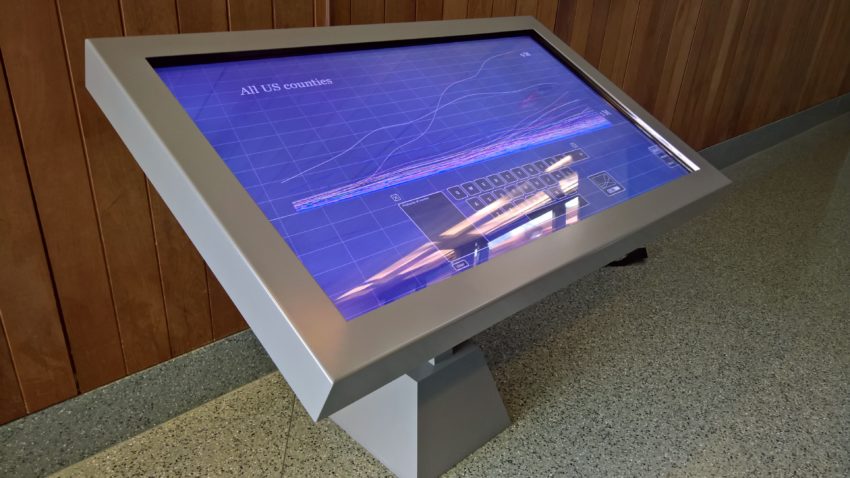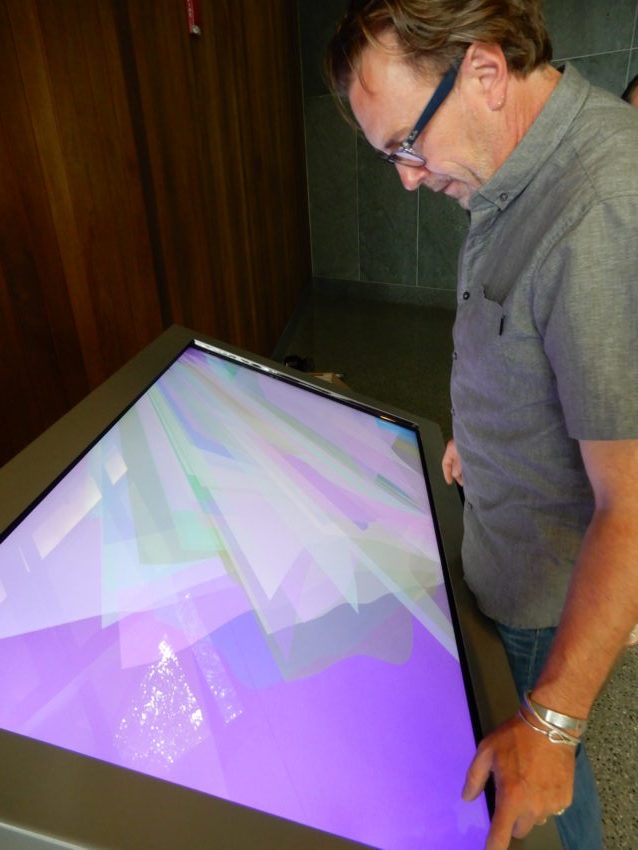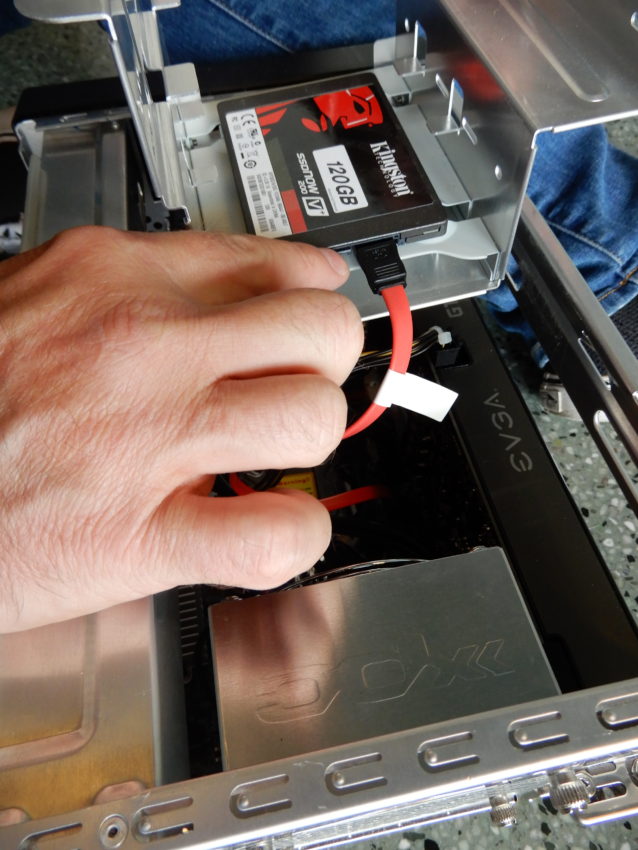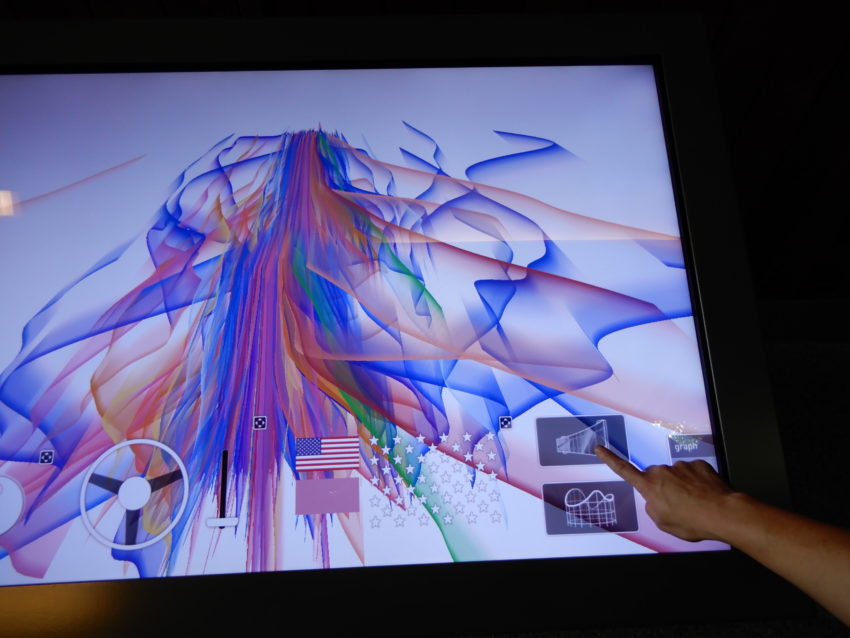Jim Gwinner, Conservator of Public Art and Sculpture, performs conservation treatment and assessments of electronic media and digital artwork. He recently completed an assessment and minor interventive treatment of American Varietal, 2013 by artist Jason Salavon which is installed at the Census Bureau Headquarters in Suitland, Maryland.

At first glance, the artwork appears to consists of a simple touch- screen, but when a visitor presses the monitor a dynamic, colorful display of United States Census data is revealed. The electronic media artwork by Salavon has a real-time multi-touch interface system that displays a three-dimensional data form representing all US counties and their populations from 1790 to 2010. This form, a collection of curved sheets or skeins, visualizes the growth of the US population, in its entirety, over the course of 220 years.

Each skein directly maps an individual county. The color is derived from the flag of the respective state in which the county resides while the shape of each corresponds to its growth.The display is interactive with users being able to choose US states, counties, as well as control the perspective of the data form -by gesture control of the touchscreen- and certain display properties such as color and transparency.

Conservator Jim Gwinner performed an assessment of the electronic media artwork, and by the summer of 2019 the artwork no longer functioned as intended. The assessment and conservation treatment of electronic media and digital artwork has many considerations, described in previous blogs such as Gesture Politics: A Time-based Media Conservation Treatment and Outdoor Electronic Media Artwork Assessment in Denver, Colorado.
These considerations often revolve around digital obsolescence in which new technology develops so quickly many hardware and software components become dated, and often, in a period of a few years. When a component inevitably needs replaced, the needed hardware, operating system, or other necessary elements are no longer supported, non-existent, or in some cases, they are sold at inflated prices if they are still available.
The condition observed from the assessment of the electronic media artwork found several issues, many of which are typical for electronic media and digital artwork. The screen was found in a non-functional state. During a previous assessment, the spare computer had been swapped and now that computer has failed.
The access panel in the base of the display stand was removed, the hardware accessed and tested. The surge protector and other hardware was in good condition and functional.

The computer was then disconnected from the system and the outer case removed. The power supply was then tested by plugging in the computer, powering on and listening for the fan to engage. The fan was not engaging suggesting that the power supply was dead.
As part of the assessment of the electronic media artwork Conservator Jim Gwinner also performed a minor interventive treatment to get the artwork functioning once more. The computer was disassembled on-site and the spare power supply was installed. The system was then checked and found to be working correctly. The computer was then placed back into the enclosure and powered up. The touchscreen was then checked and found to be functioning correctly.
Conservator Jim Gwinner also contacted the artist for information regarding the artist intention and preservation concerns. Gwinner then produced a list of the current equipment, memory and storage information, source code information, processor graphics, expansion options, operating system, and other specifications.

In addition, since the artwork was functioning an instructional video was made to demonstrate how a user interacts with the artwork. The video serves as a critical piece of documentation that still images simply cannot demonstrate.
For future preservation, Gwinner also provided as part of the assessment for the electronic media artwork recommendations to migrate the system. This allows the artwork to be preserved, or perhaps, makes “census” to the next generation.
The artist Jason Salavon as described by his online biography, uses software processes… [that] ” generates and reconfigures masses of communal material to present new perspectives on the familiar. Though formally varied, his projects frequently manipulate the roles of individual elements arranged in diverse visual populations.”
He was born in Indiana in 1970. He received a Bachelors of Arts from the University of Texas at Austin and Masters of Fine Arts from the School of the Art Institute of Chicago. His work is included in collections such as the Metropolitan Museum or Art, the Whitney Museum of Art, and Art Institute of Chicago. He is currently based in Chicago, Illinois.
